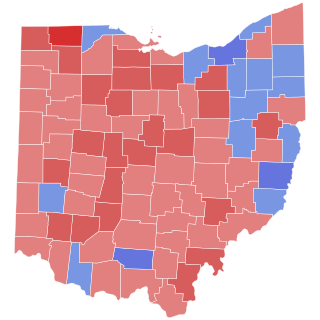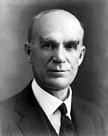
Simeon Davison Fess was a Republican politician and educator from Ohio, United States. He served in the United States House of Representatives and U.S. Senate.

The 1974 United States Senate elections were held on November 4, with the 34 seats of Class 3 contested in regular elections. They occurred in the wake of the Watergate scandal, Richard M. Nixon's resignation from the presidency, and Gerald Ford's subsequent pardon of Nixon. Economic issues, specifically inflation and stagnation, were also a factor that contributed to Republican losses. As an immediate result of the November 1974 elections, Democrats made a net gain of three seats from the Republicans, as they defeated Republican incumbents in Colorado and Kentucky and picked up open seats in Florida and Vermont, while Republicans won the open seat in Nevada. Following the elections, at the beginning of the 94th U.S. Congress, the Democratic caucus controlled 61 seats, and the Republican caucus controlled 38 seats.

The 1890–91 United States Senate elections were held on various dates in various states. As these U.S. Senate elections were prior to the ratification of the Seventeenth Amendment in 1913, senators were chosen by state legislatures. Senators were elected over a wide range of time throughout 1890 and 1891, and a seat may have been filled months late or remained vacant due to legislative deadlock. In these elections, terms were up for the senators in Class 3.

The 1934 United States Senate election in Ohio took place on November 6, 1934. Incumbent Republican Senator Simeon Fess ran for a third term in office, but was defeated by Democratic former Governor of Ohio Vic Donahey in a landslide.

The 1932 United States Senate election in Ohio took place on November 8, 1932. Incumbent Senator Robert J. Bulkley, who was elected to complete the unexpired term of Theodore Burton, was elected to a full term in office. This would be the last time that Democrats would win Ohio Class 3 Senate seat until Frank Lausche did so in 1956.

The 2014 United States Senate election in Illinois took place on November 4, 2014, to elect a member of the United States Senate to represent the State of Illinois, concurrently with the election of the Governor of Illinois, as well as other elections to the United States Senate in other states and elections to the United States House of Representatives and various state and local elections.

The 1922 United States Senate election in Ohio took place on November 7, 1922. Incumbent Democratic Senator Atlee Pomerene ran for re-election to a third term in office, but was defeated by Republican U.S. Representative Simeon Fess.

The 1952 United States Senate election in Ohio was held on November 4, 1952.

The 1958 United States Senate election in Ohio was held on November 4, 1958. Incumbent Senator John W. Bricker was defeated in his bid for a third term by U.S. Representative Stephen M. Young.

The 1946 United States Senate elections in Ohio was held on November 5, 1946, alongside a concurrent special election to the same seat.

The 1940 United States Senate election in Ohio took place on November 5, 1940. Incumbent Democratic Senator Vic Donahey did not run for re-election to a second term. In the open race to succeed him, Republican Mayor of Cleveland Harold Hitz Burton defeated Democratic U.S. Representative John McSweeney.

The 1956 United States Senate election in Ohio took place on November 6, 1956. Incumbent Senator George H. Bender, who won a special election to complete the term of the late Senator Robert A. Taft, ran for re-election to a full six-year term. He was defeated by Democratic Governor Frank Lausche.

The 1950 United States Senate election in Ohio took place on November 7, 1950. Incumbent Senator Robert A. Taft was elected to a third term in office, easily defeating Democratic State Auditor Joseph T. Ferguson.

The 1944 United States Senate election in Ohio took place on November 7, 1944. Incumbent Republican Senator Robert A. Taft, first elected in the Republican wave of 1938, was narrowly elected to a second term in office over Democratic former Lieutenant Governor William G. Pickrel, winning 71 of Ohio's 88 counties. Despite Pickrel winning the state's largest urban centers such as Cleveland, his margins there were overcome by Taft's strong showings in the rural areas and small towns. Nevertheless, at less than a point, Taft's victory was significantly smaller than his 7 point win in 1938.

The 1938 United States Senate election in Ohio took place on November 7, 1938. Incumbent Senator Robert J. Bulkley ran for re-election to a second full term in office, but was defeated by the Republican nominee, former state Senator Robert A. Taft, the elder son of former President and supreme court chief justice William Howard Taft. Taft's victory was a part of a major Republican wave nationally, where Republicans gained 8 Senate seats and 81 seats in the House of Representatives, which was largely attributable to incumbent Democratic President Franklin Roosevelts's unpopularity in the aftermath of the Recession of 1937–1938 and the President's controversial plan to add more seats to the Supreme Court, which he proposed after the court ruled some of his New Deal programs unconstitutional. Taft's victory marked the beginning of 4 consecutive Republican victories in this seat, and Democrats would not win it again until Governor Frank Lausche won it in 1956.

The 1928 United States Senate special election in Ohio was held on November 6, 1928 to elect a successor to Frank B. Willis, who died in office in March 1928. Republican U.S. Representative Theodore E. Burton, who previously held this seat from 1909 to 1915, won the open race to succeed him.

The 1926 United States Senate special election in Ohio was held on November 2, 1926. Incumbent Republican Senator Frank B. Willis was re-elected to a second term in office, defeating former U.S. Senator Atlee Pomerene.

The United States Senate special election in Ohio of 1954 was held on November 2, 1954 to complete the unexpired term of late Senator Robert A. Taft, who died in office on July 31, 1953. Interim Senator Thomas A. Burke ran to complete the term in office but was narrowly defeated by U.S. Representative George Bender.

The 1916 United States Senate election in Ohio took place on November 7, 1916. Incumbent Democratic Senator Atlee Pomerene was re-elected to a second term in office over Republican former Governor and Ambassador to France Myron Herrick.

The 1928 United States Senate election in Indiana took place on November 6, 1928. Incumbent Republican U.S. Senator Arthur Robinson, who had been appointed and elected to finish the unexpired term of Samuel Ralston, was re-elected to a full term in office.













